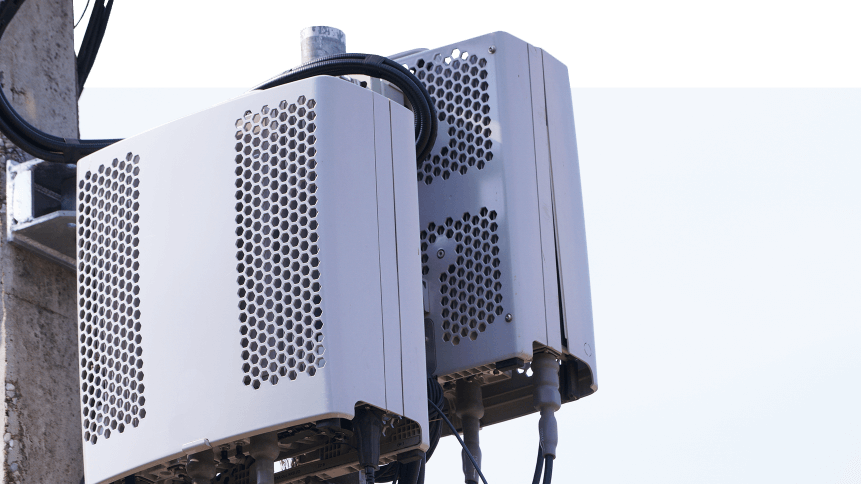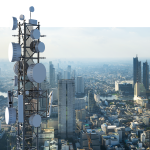Why a 5G-powered future needs a small cell revolution

Despite excitement about 5G’s potential— supplying the connectivity for IoT, ‘media everywhere’, and autonomous vehicles and drones to name just a few hotly-anticipated examples— transitioning to 5G is a lot more complex than a firmware update.
It requires a full overhaul of current cellular infrastructure. Small cells will be the backbone of these future cellular networks.
Small cells refer to low-powered cellular radio access nodes; those grey, shoe-box-like devices adorning telegraph poles and buildings that allow carriers to increase their wireless coverage over wide distances.
One FCC commissioner recently estimated that the US needs 800,000 small cells to make 5G a reality. The International Data Corporation (IDC) expects over two million by 2021.
The existing 2G/3G/4G network constructed over many years has just over 200,000 cell towers, to draw some comparison.
This demand is set to see the small cell market— led by the likes of Huawei, Ericsson, Nokia, NEC, and Alcatel-Lucent— set to take a giant leap from US$12.5 billion in 2017 to US$58.7 billion in 2024.
A deployment challenge
Of course, with Huawei’s technology banned in the States, competition in the US market lacks what is perhaps the strongest player in 5G overall. And while 5G offers faster and lower-cost connectivity, deploying even a single small cell is a time-intensive, expensive exercise.
Millions of locations must be scoured, permits acquired, and permission of private property owners sought. Even approval processes for public leases can take more than a year for a single device.
All this red tape stifles the expected scale of the 5G economy over the next few years and if things don’t change, visions of the 5G-powered future will remain a distant vision while other countries soar ahead.
A PwC report claims that in order to tackle this challenge, industry and government must team up to drive forward a “small cell revolution” that addresses public opinion, legislation, and information exchange in order to expedite the process of network development.
That initiative will manifest in three approaches:
# 1 | Changing public attitudes
Cell towers aren’t pretty— efforts to disguise them as flagpoles and trees are a little off the mark, while other methods of camouflage have included hiding them in church steeples or water towers.
Small cells are much more easy to hide; they can easily blend into the environment. Network carriers must make concerted efforts to emphasize the benefits of 5G and their unobtrusive nature, in order to start changing viewpoints to city officials, local businesses and community groups.
According to PwC, its Consumer Intelligence Series reports that consumer acceptance of the growing need for small cells is “overwhelming”. “[…] public skepticism over small cells might well evolve into acceptance, possibly even enthusiasm.”
YOU MIGHT LIKE

Will 5G nullify the workplace ‘security perimeter’?
# 2 | Drive more ‘appropriate’ regulation
Local regulations for the development of small cells are, currently, more or less the same as 150-foot cell towers. PwC urges industry to work alongside the government to drive regulatory adjustments more proportional to small cells’ smaller footprint, which would speed up and ease their rollout.
This could also comprise a tiered approach, where small cell distribution in areas such as light poles and traffic lights in commercial zones, along highways and major streets, outside malls and shopping centers, wouldn’t need a permit, so long as they complied with previously agreed standards for size and appearance.
For areas such as residential neighborhoods, parks, and school campuses, service providers would have to request a permit.
# 3 | Establish information exchange
Industry and government collaboration will benefit from the creation of a platform for small cell information exchange, where real-time information can shared around infrastructure availability, backhaul connectivity, monthly rent and permit status could be easily accessed.
Shared intelligence could make the mammoth task of deployment more manageable, while data points from social media, weather and news platforms could provide additional insight into operational planning. If all major firms collaborated, the task of regulators could also be made easier.
DoubleJump, an information exchange for the healthcare industry, is a successful example of this type of platform.
The 5G future
As excitement rises around the potential of 5G, the anticipation must be balanced with an understanding of the mountainous task of infrastructure development that lies ahead, and the need for faster, more cost-effective small cell rollout for the pace to quicken.
“Without action, the small cell bottleneck will persist, slowing the widespread availability of 5G for several years,” states PwC. “Other countries will take the lead in next-generation telecom, along with the many future industries that will depend on it.”
Other countries, China included, are already capitalizing on finely-tuned public-private coordination around the development of 5G and small cells, and the US can’t afford to wait.









